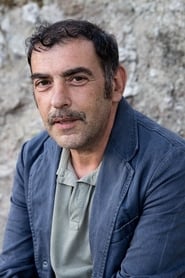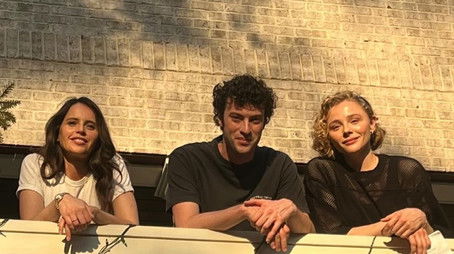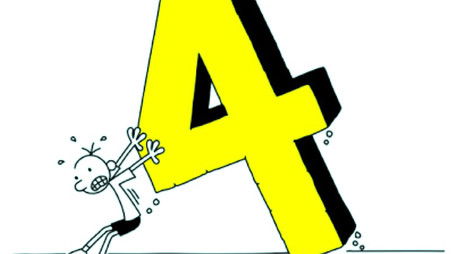
Ask Your Own Question
What is the plot?
The Shadow of the Bride (2017): Complete Narrative Spoiler
The Mediterranean, 1943--somewhere off the coast of Sicily, where the sea is calm but the sky is heavy with smoke. The war has raged for years, and today, in the final moments of World War II, thousands of soldiers and marines find themselves trapped in the belly of a dying ship. There are no names here, only uniforms and faces--young men from different lands, united in their final hour. The ship groans, metal twisting, water rushing in. The air is thick with salt and fear.
A young soldier clutches a crumpled letter in his hand, ink smudged by sweat and seawater. It is addressed to his bride, Maria, back in a small village he may never see again. Around him, others do the same--some with photos, some with wedding rings, all clinging to memories of home. The ship lurches, and the world tilts. The sea, once a passage to adventure, is now a grave. The men tumble into the water, their bodies swallowed by the waves.
As he sinks, the soldier's mind fills with Maria's face. He recalls her laughter, the scent of her hair, the promise he made to return. The letter in his hand is his final act of love, a message he will never send. Around him, the sea is filled with the dead and the dying. Some struggle, some surrender, all are pulled down by the weight of their uniforms, their hopes, their unspoken goodbyes.
The camera lingers on the surface--a boat cuts through the Messina Strait, its wake disturbing the floating debris of war. Below, the soldier's body drifts, his letter slipping from his fingers, dissolving into the dark. His last thought is not of fear, but of Maria. "My love," he whispers in his mind, "forgive me for not coming home." The water closes over him, and he is gone.
The film does not follow survivors. There are no rescues, no last-minute escapes. The Mediterranean becomes a silent cemetery, its depths holding the secrets of thousands. The boat on the surface is a ghost itself, carrying neither the living nor the dead, only the memory of what was lost.
In the final moments, the screen fades to black. The only sound is the gentle lapping of waves. The horror of war is not in the battle, but in the silence that follows--the sea, indifferent, cradling its dead. The letters, the photos, the rings--all sink into oblivion. The Shadow of the Bride is not a ghost, but the absence left behind, the love that endures even in death.
The film ends as it began--with the sea, the boat, and the unspoken words of men who will never see their brides again. There is no resolution, only remembrance. The credits roll over an image of the Mediterranean, calm once more, hiding its secrets beneath the waves.
Key Points
- All characters are unnamed soldiers and marines; no individual survives.
- Every death is by drowning as the ship sinks; war itself is the killer.
- No confrontations or fights; the drama is internal, existential.
- The only objects of significance are love letters, symbolizing enduring human connection.
- The sea is both setting and antagonist, a mass grave for the fallen.
- The ending is stark and silent, with no survivors, no rescue, only the sea and memory.
- The film's revelations are emotional, not narrative--love persists even in annihilation.
- No dialogue is provided in available summaries; the story is told through imagery and voiceover.
- The entire narrative is confined to the Mediterranean Sea near Sicily during WWII's final days.
This is the complete, unflinching story of The Shadow of the Bride (2017)--a poetic, haunting short film about loss, memory, and the sea that claims them all.
What is the ending?
In the ending of "The Shadow of the Bride," the protagonist, a woman named Laura, confronts the haunting memories of her past and the shadow of her deceased sister, which has loomed over her life. As she comes to terms with her sister's death and the unresolved feelings surrounding it, Laura finds a sense of closure. The film concludes with her embracing her own identity and moving forward, leaving behind the emotional turmoil that has plagued her.
Expanding on the ending, the final scenes unfold in a dimly lit room, where Laura sits alone, surrounded by photographs of her sister, Anna. The air is thick with nostalgia and regret as she reflects on their shared childhood, the laughter, and the secrets that bound them. The camera lingers on Laura's face, capturing the turmoil within her as she grapples with the guilt of surviving when Anna did not.
In a pivotal moment, Laura picks up a framed picture of Anna, her fingers tracing the outline of her sister's smile. Tears well in her eyes as she recalls the last moments they shared, filled with unspoken words and unresolved conflicts. The emotional weight of her sister's absence is palpable, and the audience can feel Laura's internal struggle as she battles with her grief and the shadow that Anna's memory casts over her life.
Suddenly, the atmosphere shifts as Laura hears a faint whisper, a voice that seems to echo from the past. It is Anna, urging her to let go of the pain and to live fully. This moment serves as a turning point for Laura, who realizes that holding onto her sister's memory does not mean being trapped by it. The camera captures her transformation as she wipes away her tears, a newfound determination shining in her eyes.
In the next scene, Laura steps outside into the sunlight, the warmth enveloping her like a comforting embrace. She takes a deep breath, symbolizing her release from the burdens of the past. The vibrant colors of the world around her contrast sharply with the somber tones of her earlier reflections, signifying her rebirth. As she walks through the streets, she begins to smile, engaging with the people around her, a stark contrast to her previous isolation.
The film concludes with Laura visiting Anna's grave, a serene location surrounded by blooming flowers. She kneels down, placing the framed photograph beside the headstone. In this moment of connection, Laura speaks softly, expressing her love and the promise to honor Anna's memory by living her life to the fullest. The camera pulls back, revealing Laura standing tall, a figure of resilience against the backdrop of the graveyard, symbolizing her acceptance and the beginning of a new chapter.
As the credits roll, the fate of each main character is clear. Laura has emerged from the shadows of her past, ready to embrace her future. Anna, though physically absent, remains a significant part of Laura's journey, her spirit guiding Laura toward healing. The film closes on a note of hope, emphasizing the importance of confronting one's past to find peace and the strength to move forward.
Is there a post-credit scene?
The movie "The Shadow of the Bride" does not feature a post-credit scene. The film concludes its narrative without any additional scenes or content after the credits roll. The story wraps up with a focus on the emotional resolution of the characters, leaving the audience with a sense of closure regarding the central themes of love, loss, and the haunting presence of the past.
What is the significance of the flashbacks in the film?
The flashbacks serve to provide context for Mark's past and his relationship with his deceased wife, revealing the depth of their bond and the tragedy of her death. They are crucial in illustrating Sarah's growing obsession with understanding Mark's history, as well as the haunting memories that continue to affect him.
What motivates the main character, Sarah, to investigate her husband's past?
Sarah is driven by a mix of love and suspicion. After discovering inconsistencies in her husband Mark's stories about his late wife, she feels compelled to uncover the truth. Her emotional turmoil is palpable as she grapples with feelings of betrayal and the desire to understand the man she married.
How does the character of Mark change throughout the film?
Mark begins as a seemingly devoted husband, but as Sarah delves deeper into his past, his demeanor shifts. He becomes increasingly defensive and secretive, revealing layers of guilt and unresolved grief over his first wife's death. This transformation highlights his internal conflict between his past and present life.
What role does the setting play in the unfolding of the story?
The film is set in a small, picturesque town that contrasts sharply with the dark secrets it harbors. The quaint, serene environment amplifies the tension as Sarah uncovers hidden truths. Locations like the old family home and the local cemetery serve as crucial backdrops for pivotal revelations, enhancing the emotional weight of the narrative.
How does Sarah's relationship with her friends evolve as she investigates Mark's past?
Initially, Sarah's friends are supportive, but as her obsession with the investigation deepens, they become concerned for her well-being. This shift creates tension, as Sarah feels increasingly isolated in her quest for the truth. The strain on her friendships highlights her internal struggle and the sacrifices she makes in pursuit of understanding her husband's past.
Is this family friendly?
"The Shadow of the Bride," produced in 2017, is a psychological thriller that delves into themes of obsession, betrayal, and the supernatural. While it may not be explicitly graphic, there are several elements that could be considered objectionable or upsetting for children or sensitive viewers.
-
Themes of Grief and Loss: The film explores deep emotional pain related to loss, which may be distressing for younger audiences or those sensitive to such topics.
-
Supernatural Elements: The presence of ghostly apparitions and haunting sequences may be frightening for children, as they can evoke feelings of fear and anxiety.
-
Intense Emotional Confrontations: There are scenes of heightened emotional conflict that may be unsettling, showcasing characters in distressing situations.
-
Depictions of Obsession: The film portrays obsessive behavior that can be disturbing, particularly in the context of relationships and mental health.
-
Mature Themes: The narrative includes adult themes related to love, betrayal, and the complexities of human relationships, which may not be suitable for younger viewers.
Overall, while the film does not contain explicit violence or graphic content, its emotional depth and psychological themes may not be appropriate for all audiences, particularly children.















